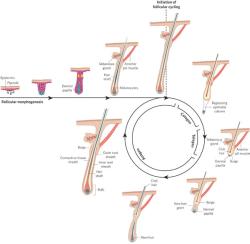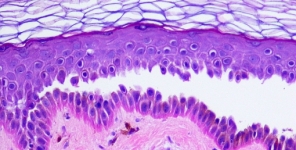I cambiamenti nel ciclo del capello durante la gestazione e il periodo post-partum
 A causa dei cambiamenti ormonali durante la gravidanza, un numero maggiore di follicoli piliferi rimangono nella fase anagen per periodi più lunghi e ritornano alla fase telogen entro i 3-6 mesi dal parto in corrispondenza di un improvviso calo dei livelli ormonali. Ciò si traduce in un'eccessiva perdita dei capelli nota come telogen effluvium post-partum.
A causa dei cambiamenti ormonali durante la gravidanza, un numero maggiore di follicoli piliferi rimangono nella fase anagen per periodi più lunghi e ritornano alla fase telogen entro i 3-6 mesi dal parto in corrispondenza di un improvviso calo dei livelli ormonali. Ciò si traduce in un'eccessiva perdita dei capelli nota come telogen effluvium post-partum.
Obiettivo
Determinare i cambiamenti nel ciclo del capello durante la gestazione e il periodo post-partum.
Metodi
Nello studio sono state incluse 116 donne: 28 donne erano alla 24esima settimana di gravidanza, 30 erano al termine della gestazione, 29 nel 4° mese dopo il parto, e 29 nel primo anno di post-partum.
È stato registrato il numero di madri che allattavano nel periodo post-partum e anche il mese in cui sono state esaminate. Utilizzando il Trichoscan, sono stati misurati i rapporti tra anagen e telogen.
Risultati
Tra i gruppi, è stata osservata una differenza statisticamente significativa in termini di rapporti tra anagen e telogen (P = 0.042, P = 0.042). Nei confronti inter-gruppo, il tasso medio di anagen al 4° mese di post-partum è stato significativamente inferiore rispetto a quello del 6° e 9° mese di gravidanza (P = 0.045, P = 0.038); mentre il tasso medio di telogen è stato significativamente superiore (P = 0.045, P = 0.038).
Il tasso medio di anagen al 4° mese di post-partum e nel gruppo di allattamento è stato significativamente superiore rispetto al gruppo che non allattava (P = 0.014); mentre il tasso telogen medio è stato significativamente più basso (P = 0.014).
Nel primo anno di post-partum (P = 0.385), non c'è stata alcuna differenza statisticamente significativa tra i due gruppi (il gruppo di allattamento e quello che non allattava) in termini di rapporto tra anagen medio e telogen medio.
Conclusione
Il tasso di anagen è aumentato durante la gravidanza e il tasso di telogen è salito solo dopo il parto; tuttavia, nella maggior parte delle donne questi cambiamenti non sono repentini o esagerati.
Storia della pubblicazione:
Titolo: The changes in the hair cycle during gestation and the post-partum period
Rivista: Journal of the European Academy of Dermatology and Venereology. doi: 10.1111/jdv.12188
Autori: S. Gizlenti, T.R. Ekmekci
Affiliazioni:Department of Dermatology, Haydarpasa Numune Research and Training Hospital, Istanbul, Turkey
Abstract:
Background In pregnancy, increased numbers of hair follicles remain in the anagen phase for longer periods due to hormonal changes and return to the telogen phase within 3–6 months of delivery with a sudden drop in hormone levels. This results in excessive shedding of hair known as post-partum telogen effluvium. Objective To determine the changes in the hair cycle during gestation and the post-partum period. Methods We included 116 women in this study; 28 women at the 24th week of pregnancy, 30 pregnant women at term gestation, 29 women in the 4th post-partum month, and 29 in the first post-partum year. The number of breastfeeding mothers in the post-partum period and the month in which they were examined were also recorded. The ratios of anagen and telogen were measured using Trichoscan. Results A statistically significant difference was observed between the groups in terms of the anagen and telogen ratios (P = 0.042, P = 0.042). In the inter-group comparisons, the mean anagen rate in the 4th post-partum month was significantly lower than that in the 6th and 9th month of pregnancy (P = 0.045, P = 0.038), while the average telogen rate was significantly higher (P = 0.045, P = 0.038). The mean anagen rate in the 4th post-partum month in the breastfeeding group was significantly higher than that in the non- breastfeeding group (P = 0.014), while the mean telogen rate was significantly lower (P = 0.014). There was no statistically significant difference between the two groups (the breastfeeding and non-breastfeeding groups) in terms of the mean anagen and mean telogen ratios in the first post-partum year (P = 0.385). Conclusion The anagen rate increases during pregnancy and the telogen rate rises after delivery, however, there is no exaggeration in these changes in most women.





